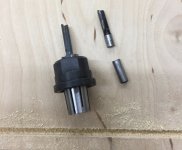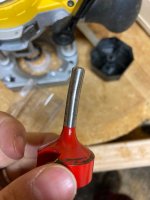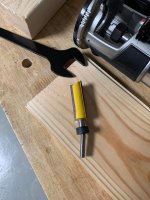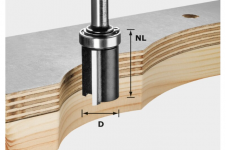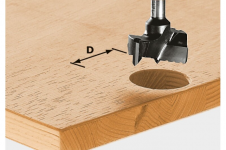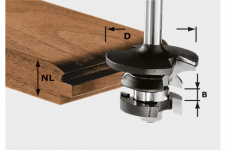Packard
Member
Michael Kellough said:[member=74278]Packard[/member] Jeff spelled it out above, “On cuts that are at the upper limit of what 1/4" shank should do, the 8mm shank provides additional stability. Case in point is dovetail bits. A half-inch dovetail bit with 1/4" shank is a screamer in a dovetail jig. You can't overcome that by making multiple cuts...you have to cut to full depth in one pass or your dovetail is a Christmas tree. The same bit in 8mm is much stiffer, and vibrates far less, which means the dovetail cut is much more consistent.”
I think we are looking at this all wrong.
I have both a 1/4” and a 1/2” diameter pattern bit with a bearing on the end.
The 1/4” is handier. It gets into tighter corners and rides in a compact router. But the 1/2” has a longer shaft and can handle thicker material.
So, was Whiteside worrying that I would bend or break the shaft if they made the longer one out of 1/4” also? I don’t think the relatively short height of a router would provide the leverage needed to damage the shaft.
I think the issue is the bearings in the router itself. I think the issue is that with a machine designed for 1/4” bits will not have sufficient space to incorporate the larger bearings needed for the larger bits.
It is not the shaft strength of the bit that is at issue, it is the machine’s’ spindle bearings capacity to handle lateral stresses. The larger shaft diameter simply prevents users from overloading the bearings in undersized machines.
In any case, try and bend a 1/4” diameter heat treated drill rod with the equivalent leverage that a router provides. I’m pretty sure that the approximately 10” height being pushed laterally on a flat base is not capable of bending or breaking the shaft. It is capable of damaging the machine’s bearings however.
ADDENDUM: I have written to Whiteside asking for their thoughts on this discussion. If they respond, it will likely not be before Monday, the beginning of the work week.
I don’t think the members here have sufficient experience to drive this conversation to a consensus.
This is likely not the typical question that they [Whiteside] typically fields, so they may take extra time, decide that they don’t want to comment on a forum thread, or that I blindsided them with the question and they need extra time.
I linked this thread. Whiteside might find this interesting reading regardless.
Packard

